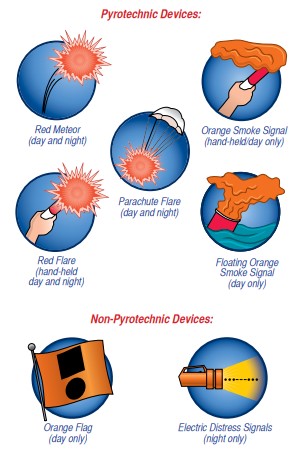Every sport and activity has gear; safety gear is a must-have with boating! In the motorized boating world, gear is also referred to as "equipment," and some items must be carried on board. And what type of equipment varies by the length of your boat and the propulsion.
Equipment and requirements for boats 16 feet to less than 26 feet:
1. Wearable Life Jackets
Boats under 26 feet need to carry properly fitting, U.S. Coast Guard-approved wearable life jacket(s) for each person on board and the life jacket must be readily accessible. The boat must also carry a Type IV throwable cushion. All children 12 and younger are required to wear a life jacket while on an open deck or cockpit when a boat is underway or being towed.
*Motorboats less than 16 feet in length and all paddlecraft need to carry properly fitting, U.S. Coast Guard-approved life jacket(s) for each person on board and the life jacket must be readily accessible but are not required to carry a Type IV throwable cushion.
A boat less than 39 feet 4 inches (12 meters) must carry a sound-producing device such as a whistle or compressed air horn. It's easy to attach a whistle to a life jacket. Both are required equipment.
3.
Fire Extinguisher when no fixed fire extinguishing system is installed. Every motorboat, except outboard motorboats less than 26 feet in length of open construction, shall carry on board, fully charged and in serviceable condition a B-I (or 5-B) type hand portable, marine-approved fire extinguisher.
7.
Navigation Lighting -Lights are required only when the boat is underway or at anchor between sunset and sunrise and during restricted visibility.
Engine Cut-Off Switches: A Federal boat engine cutoff switch law went into effect on April 1, 2021. This law applies to operators of motorboats under 26 feet for on-plane or at displacement speeds. Oregon approved rules in alignment with federal law and requires the use of an engine cut-off switch while operating a motorboat at a planing speed. The rule does not apply if the boat is not equipped with an engine cut-off switch or the main helm of the boat is installed within an enclosed cabin.
Visual Distress Signals (Saltwater)All boats operating in the ocean or coastal waters west of the line of demarcation (jetty tips) must carry U.S. Coast Guard-approved VDS.
VDS allows boat operators to signal for help in the event of an emergency.
There are three categories of visual distress signals:
1. Day signals (visible in bright sunlight)
2. Night signals (visible at night)
3. Both day and night signals
VDS are either pyrotechnic (smoke and flames) or non-pyrotechnic (non-combustible and electronic). Operators must select the appropriate devices and have the minimum quantity as referenced in
33CFR175.110 depending on which category. VDS must be U.S. Coast Guard-approved, in serviceable condition, and readily accessible.
If pyrotechnic devices are selected, a minimum of three must be carried. Any combination can be carried as long as they add up to three signals for day use and three signals for night use. Three day/night signaling devices meet both requirements. There's a variety and different combinations of pyrotechnic devices that can be onboard to meet the carriage requirements.
The most common U.S. Coast Guard-approved non-pyrotechnic devices are an Orange Day Flag (day) and Electronic Distress Signal (night) to meet requirements.
